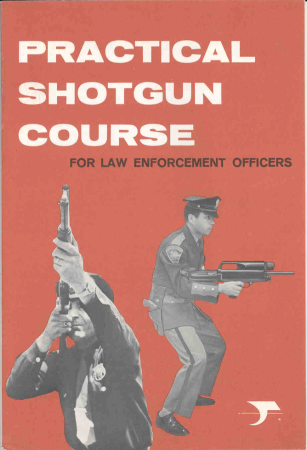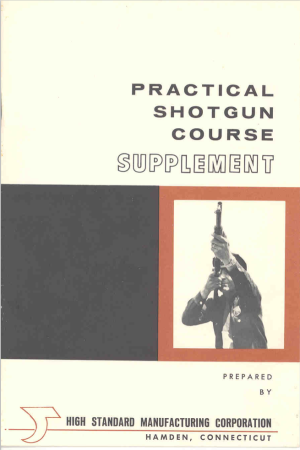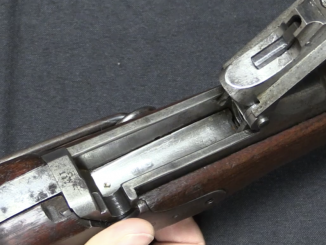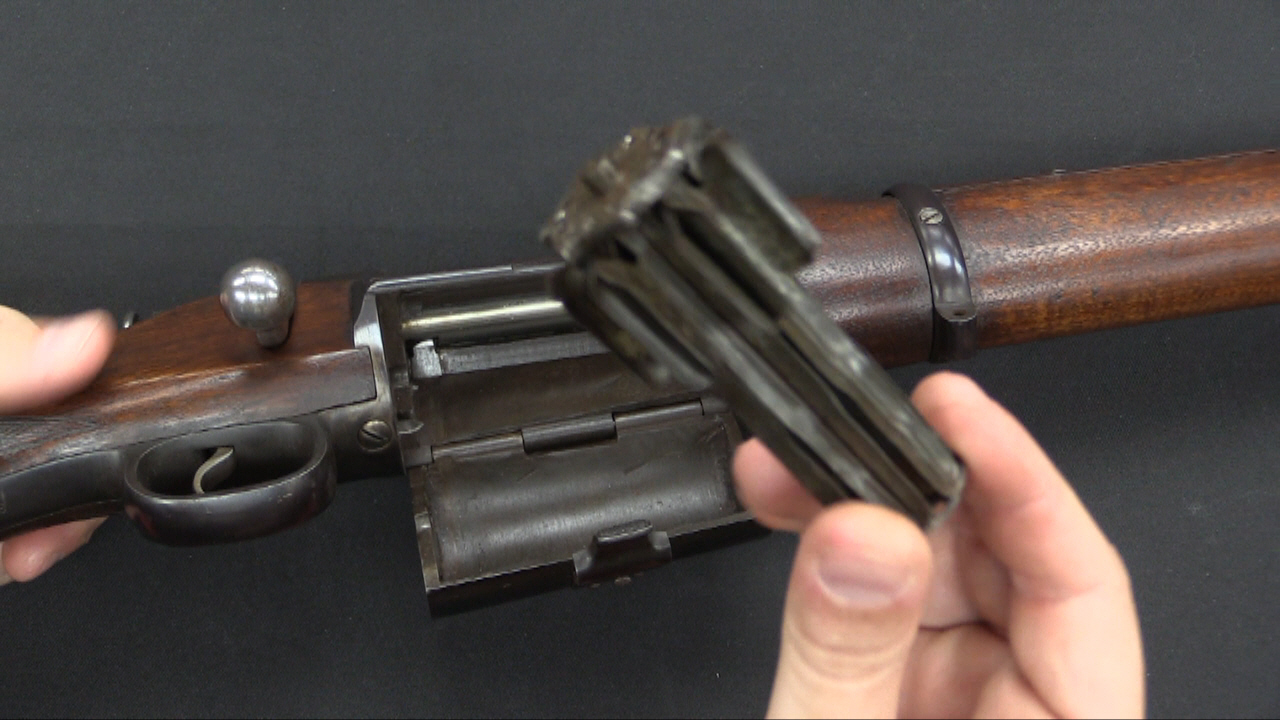The High Standard Model 10A and 10B were a pair of bullpup police shotguns produced for about 10 years in the late 1960s and 1970s. They were built around a regular High Standard semiautomatic shotgun action, which was put into a plastic chassis to give it a bullpup configuration. They were chambered for 12 gauge, 2 3/4 inch shells, and required high-brass or other full-powered ammunition to run properly.
The idea of the bullpup layout really did have merit for the purposes High Standard intended, although the guns were not executed as well as they could have been. In theory, the short overall length made the guns very handy for using in and around patrol cars, and the ability to effectively hold and fire the gun with only one hand would allow an officer to use his other hand for things like opening doors, moving obstacles, handling objects, etc. The integrated flashlight (molded into the chassis on the 10A and detachable on the 10B) differs from today’s tactical weapons only in that traditional Mag-Lite type lights (specifically, the Kel-Lite) were used instead of today’s smaller and more powerful options.
The carry handle, folding front sight, flashlight mount, rotating buttplate, and very non-traditional appearance made for quite the eye-catching gun when these weapons hit the market. Many police departments purchased them with the idea of modernizing, only to find them less practical in reality than in marketing, and they went out of production by the late 1970s.
For folks who are interested, here are a couple training documents published by High Standard on shotgun usage:






An interesting shotgun. Did you consider a dab of threadlock on that loose hammer pin? Just something to hold it in place long enough to get a few shots off without permanently fixing it in place.
Anyone know someone who has parts for these I got one and it’s kissing the carry handle and flashlight, I already looked at numrich, they got the handle and handle spring but no bolt or flashlight.
Obligatory movie reference: it was used in Michael Mann’s Thief by then Chicago cop turning actor Dennis Farina to shoot Jim Belushi, James Caan’s partner, near the climax of the film.
Obligatory movie reference: Richard Roundtree (John Shaft … and we can dig it) used one to pop out of a casket and take down them whitey mobsters. And their helicopter.
I was going to joke about that. That shotgun looks much smaller than it appears on the poster for Shaft’s Big Score.
Always wondered what that was.
The real-life cop played one of the bad guys, and a real-life thief (detective Urizio) played a cop. Go figure.
To learn the modern technique for the movie, James Caan went to Gunsite. Cooper said there was no way that an ex-con (who spent ten years in jail and got out around 1979) would know it. Instead, Chuck Taylor instructed James Caan. The movie gun play is complete with the press-check technique, tactical reload before running dry, slicing the pie, etc. interestingly enough, most people Caan’s character shot had to be shot a couple of times before they stayed down, maybe more realism.
Had to run through a weekend’s worth of comments to see if anyone mentioned, but the High Standard was also used in the Dick Tracy comic strip in the 70s and laid waste to any number of hideously malformed criminal masterminds bent on world domination. Video-transmitting wrist phones played a role as well, I think. I can so dig Shaft… the movie was based on a series of novels that are minor black-lit classics. There was one (think it was the original “Shaft”) where after a series of justifiable homicides the NYPD have seized all of Shaft’s regular carry guns, and he has to go to the “.44-40 Smith and Wesson” (not specified if it was a breaktop or N-frame) that he had hanging from a nail over the door in the closet, which he tucked into the front pocket of his pullover and hit the street feeling “as secure as a kangaroo with a hand grenade in his pouch.” One of those lines that sticks with you through decades of concealable carry of spectacularly unconcealable handguns of questionable provenance.
It was also used in a comic book series, the name of which I’ve long forgotten. It was a about a GI in Vietnam who always carried a shotgun, eventually switching from a 12ga. side by side to the High Standard.
Good old Chuck Taylor. Invented the “Combat Master” course of fire and then announced he was the first guy to pass it. Pardon me while I catch my breath!
In Dept. of Corrections they use birdshot for shooting lower extremities in a quick reaction force. It’s considered less-than-lethal and deploys with CS gas launchers, knee knockers, etc.
Not my department. 00 Buck, rubber pellets and baton rounds, as well as other munitions I am not currently allowed to discuss ( still employed).
One comment from a grumpy old cop. The Kel-lite was NOT an off brand Maglite. It was the fore runner of all heavy bodied aluminum flashlights. When I started working as a policeman in the late 70s, everyone carried a Kel-lite! It was a huge improvement over any other light you could buy.
https://en.m.wikipedia.org/wiki/Kel-Lite
I’ll second that. I carried a 5-cell Kel-Lite for years in a baton ring. Durable and much handier than the clumsy D-cell Maglite of today (Maglite does make C-cell lights up to 4-cell). And somewhere out there, there’s a thief who tried to stab me with a screwdriver who has a scar that reads “Kel-Lite” backwards on his forehead.
Do you know:
One of competitor to the Kalashnikov AK was bull-pup fire-arm: ТКБ-408
https://en.wikipedia.org/wiki/TKB-408
I’m wondering that it was invented independently or inspired by PzB M.SS.41
http://world.guns.ru/atr/de/pzb-mss41-e.html
Itself interesting gun, which was say “inverted bolt-action” (non-moving breech, moving barrel, see link)
Cool video and thanks for the memories. I had a 10B as a house gun back in the ’80s when I lived on the fringe of “crack town” in New Orleans. It had a working Kel-Light and the original padded sling. It hung on a bedpost, and was good for checking on those numerous bumps in the night one hears when living in a 150 year-old house on the border of a REALLY bad neighborhood. It ran just fine with Federal Premium OO Buck, but I always had the feeling that it was just one trigger pull away from a major failure. It eventually got traded away, but seeing that video reminds me of some crazy times.
Seems that it might have benefited from some design tweaks: stake that pin in place, for example. Also, instantly removable magazine/gas system (no screw-driver) so the barrel cold come out like the Remington. Personally, I’d think about omitting the charging lever and replacing it with a fore-finger slot/safety mechanism like the M3 grease gun. Of course, that cross-bolt safety is probably a better idea. Still…
Make one in 20-gauge that can run reliably, and I think with the right HD marketing strategy, it would sell like hot-cakes!
I really think the 10A-B series were a bit ahead of their time. Like I said, I lived near a really rough part of town (3 classmates murdered in 4 years just for passing through the “wrong” neighborhood at night) and the possibility of burglary or home invasion were always present. If you understand the somewhat unique neighborhood arrangement in New Orleans, you see that one street may separate an upscale residential area and “the hood.” Many nights I had to check on things, and the compact design along with the attached flashlight made it ideal for moving through a big old house in the dark. The ergonomics were good for an entry/house-clearing gun and the attached flashlight, while a bit dated, was useful. Let’s just say that after a couple of “incidents,” word got out that I was “the crazy gun-guy” and things got a bit more quiet around my place. I have a Kel-Tec KSG set up for that role, now, although I live out in the country and am more worried about four-legged predators. Still, I thing an updated version of the Hi-Standards would be popular HD weapons.
Maybe a aftermarket spinny around 10b style butt plate would sell to Ksg owners, if there is any merit to it i.e. Allowing you to shoot with one hand, more effectively.
In between racking the action, being pump action.
Might help, in shooting around corners… If you imagine holding the pistol grip sideways with butt plate vertical against your bicep.
Instead of a torch, have a camera, Bluetooh to your iphone lark – Pop your arm round the corner, hold your phone look at the lasers position for sighting.
Probably better for a semi auto bullpup.
Smith and Wesson 3000 made by Howa in Nara, Japan in May 1983. Used by Pontiac, MI PD for oh, 25 years before I got it. Externally a bit dinged up, donut stains, but internally like new…
Nara or Nagoya,I know that Howa has a large factory here in Nagoya they make weapons for the J.P.S.D.F.
OK, my bad. As a lad of 17 I was graciously invited to dinner by an officer in the JSDF–“army” in the artillery with a bunch of his colleagues who flew helicopters. As you might expect, I asked about Japanese small arms. I was told the Type 64 was excellent for Japanese soldiers, relatively compact, hard-hitting, accurate, “but made in Japan, so many small parts!” Beers were refilled after this joke! I’ll be sure to double-check on the Japanese firearm industry…. Thanks for the correction!
Speaking of post-war Japanese firearms, I’ll always remember the Nikko “Shadow Indy” series of O/U shotguns, principally because of the hot Japanese models in their adds in “Guns” magazine!
Sounds like it was a good time. It’s cool to hear the sound of heavy weapons range practice for one weekend in August. Nothing like the sound of .50cal,30mm, and 105mm or 120mm M.B.T. guns in Nagoya. By the way my BPS is my favorite.
I worked a bit with the 10B in the Seventies (we had one in the arms cabinet). Mainly, I found that it didn’t like anything much less powerful than 00 Buck, 2.5 dr. equiv. charge, and it really couldn’t be fired from the left shoulder unless you liked the empty bouncing off your right shoulder.
Also, with the flashlight mount and the sight setup, firing as shown on the cover of the HS shotgun manual (half-crouched, buttplate in crook of elbow, other hand over top to control recoil uptick) was really the most practical way to use it.
One wag commented that it was the only shotgun designed specifically for the Jerry Usher method of revolver point shooting.
On the whole, I stuck to my Winchester ’97.
cheers
eon
The idea of a bullpup fighting shotgun is a very good one. To date we have not seen the winning implementation of that concept, the gun that turns out to be a world changer rather as the Glock did for striker fired pistols (they’re everywhere now) or the Mauser did for bolt rifles. A part of the problem is that the garden variety riot gun is an excellent weapon, thoroughly proven, widely available and modest in price. That’s a lot of plusses for a new gun to overcome.
Of course the High Standard would have had better prospects for success if it had worked better…
Good points… The High Standard 10 series seems to be a great concept poorly executed. The problem is that it is cripplingly over-specialized and it inherently cannot keep itself from malfunctioning due to manufacturing uncertainties (that bothersome pin). Too bad it wasn’t designed to chamber commercially available ammunition (fat chance the chief wants to buy guns that require ludicrously expensive ammo). Or am I wrong?
Butt stroking: particularly with a short gun like this, an accidental discharge could be rather unfortunate for the user! Not a practice to be encourage I think.
The gun shown seems to have been worked on — both the weird flashlight mount, and the sling swivel on top of the sight/flashlight base. The “Kel Lite” was held much closer to the body of the gun by the original mount. Good luck finding the correct Kel Lite nowadays!
Ian, whose camouflage pattern is that on your pants?
1980’s – 1990’s era US military desert camo, AKA chocolate chip pattern?
http://blog.cheaperthandirt.com/kel-tec-unveils-the-new-ksg-dual-tube-pump-shotgun/
Ian, have you started some new forearm exercise, or are you just working out more in general?
Those High Standard publications were almost certainly authored by Chic Gaylord, who had a longstanding contract with them for training and demonstrations of HS products.
I was working my first cop job for a dinky little P.D. in the mid-90s, when the Sheriff’s Office decided to modernize. The Sheriff was kind of a gun nut, and he decided the local coppers would be allowed first coach at the old stuff, we just had to match whatever the trade-in value was they were going to get from the place they were buying the new guns from. Anyway, they had one of these, the ‘A’ model, and three of the semi-auto-only Reisings. I decided that I just absolutely could not live without the 10A. Carried it in the car for a few years, but it eventually got traded for something. I never shot it a lot, maybe 300 rounds total, and only with 00 buck. At some point, somebody had painted a black X on the lens, which kinda-sorta made a cross hair in the light for point-shooting. The biggest problem with the whole setup was the light just wasn’t bright enough. Knowing what I know now, don’t think I would want it for a working gun again.
I had a Hi-Standard model 10-B and mine didn’t work, either. Maybe it was the same problem with that loose pin. Also, as Jeff Simpkins pointed out in an earlier comment, Kel-Lite was not an off brand Maglite. If anything it was the opposite as Kel-Lite had its debut in 1968 and Maglite in 1979. (The source for the dates is Wikipedia) Most of the officers I knew carried Kel-Lite flashlights and only a few carried Maglite flashlights. Later on the Streamlight SL-20 dominated the LE flashlight market. By the way, I’m not picking on Ian- he’s a firearms guy and not a flashlight historian. I enjoyed the segment as I had hoped that Ian would cover this particular firearm.
A friend of mine collects odd shotguns. He bought a SPAS-12 and some other stuff, and I suggested a Model 10. He found an NIB 10B at his local gun shop…
I don’t know that he’s ever had any trouble with the gun mechanism in the 20-odd years he’s had it, but the recoil just beats the flashlight bits to death. When he got the batteries sorted out, the filaments in the bulbs would break quickly. He was looking into LEDs last time I checked.
He did make a mod a few years ago, grafting an extension on the magazine to bring it out flush with the muzzle. Neither one of us could figure out why High Standard didn’t do that to start with…
Unfortunately I’ve never shot the gun; it is right-handed, and I am not.
Briefly used in Brazil by Rio de Janeiro’s PMERJ (Military Police). O wrote an article on it in the 1994 edition of Harris Publications’s SPECIAL WEAPONS magazine.
My Favorite 2 shotguns, the M10A had a NON Detachable flash lite, while the B had a removable one on the left side. I’ve never seen but 2 Bs with the light still on them since it was removable. Unfortunately High Standard would only sell these to the police. So they ALL came into the market via police trade ins. Anyone see the movie, “Shaft’s BIG SCORE” ? Roundtree has one. On the cover of the LP he’s in a speed boat shooting down a Helicopter with one.
Yeah, baby!
I was looking at the Rock Island Auction site and saw a 10A up for sale in a lot with a Mossberg bullpup. http://www.rockislandauction.com/viewitem/aid/1026/lid/763
I bought a 10B just after they went out of production. I paid $289 (as best I remember) with the flashlight included. To test the gun for functionality I shot a few rounds of skeet with it. Never had a malfunction. When, for some reason I want a loaded gun around home, the 10B is what I choose, but not with skeet ammo. The idea of a one handed gun with light is, in my opinion the ideal home defense gun. That leaves you a spare hand to be calling 911, opening a door or whatever, and you can see what you might be looking to shoot. I understand that the Army tested the 10B during the Viet Nam era but ruled it out because of operating rod failures that prevented it from passing their 5,000 round life test. I don’t think I want mine to ever be shot 5,000 times. Further, after I got mine I noticed that a company in LA called Survival Inc. had a supply of the special Kel-Lite flashlights for sale at almost give away prices. I wish I had bought a case of them.
I would wager that if the can be used in this video had been sent to high standard while it was still under warranty that it would’ve come back with a larger pan that prevented the problems shown in the video.
Part looks like about 1/8 inch in diameter. It might have been expressed on the engineering drawing of the part as 0.125″ +/- 0.001 “. This would have allowed the machinist making the part in the inspector to accept parts between 0.124″ and 0.126″. Likewise the hole it goes into would be expressed about the same way except 0.124″ as the base diameter. The diameter of the whole then would be between 0.123″and 0.125″. All would be fine except when the pen turned out to be 0.124″ in the hole was 0.125”. Then the problem as shown in the video could’ve occurred.
The solution from high standards point of view would be to tighten the tolerances.
This however would not have solved all of the 10B’s problems. It had three real fundamental problems for which a simple fix could not be found.
1. Flashlight. As stated in the video the 10 B was supplied with a Kel-Lite flashlight. At the time this was hands down the best made most rugged flashlight on the market and became the standard for police use. It remains such until Maglite improved on the design and successfully competed against it. It was clearly the flashlight high standard should have used.
The problem with using the flashlight on the 10B was the shock and vibration of the gun firing. The flashlight had to heavy D cell batteries. When the gun recoiled the batteries flew back and forth within the flashlight, eventually destroying it.
Maglite solve this problem in two ways one by using new technology lightbulbs that put out more light with less electrical power so that AA and AAA batteries could be used rather than the heavy D cells. Second Maglite built in a stronger support block between the battery and the bulb.
2. Reputation. The 10B developed a reputation for unreliability. I do not know if this was based on real problems such as that shown in the video, other problems, or simply rumor. In any case police departments across the country decided not to buy the 10B.
3. Military sales. Several military organizations were very interested in the 10B, especially the United States Air Force. The Department of Defense put the gun through its standard military acceptance trials. The test, I believe, were repeated three times and each time the test guns had the operating rod break.
As pointed out in the video the basis of the 10 B was a standard commercial shotgun which would not normally get shot 5,000 or 10,000 times using high brass 00 buckshot. The operating rods were simply not strong enough. This basically ended the chance of large military sales.
need a metal sigh 20inchtop to bottom and 15 inches from side to side, that reads there comes a time every now and then when i must reach for my model 10.